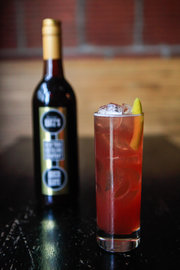
For centuries, the phrase “doctor’s orders” has been invoked — with a rakish grin and a wink — as a handy excuse for downing spirits. Few liquors have benefited from this dodge more than rock and rye.
An unlikely blend of rye whiskey and rock candy syrup, with an array of citrus and other flavors typically thrown in, rock and rye was a barroom staple for much of the latter 19th century, often taken for “what ails you.” But it all but vanished after Prohibition, save for a few bottom-shelf brands.
This distinctly American liqueur is back, in a small way, with some added cachet. Robert Cooper, the liquor entrepreneur who gave the world the elderflower liqueur St.-Germain, released Slow & Low rock and rye in 2012; today it is available nationwide. And New York Distilling Company in Brooklyn recently released its long-in-development Mister Katz’s Rock & Rye.
Allen Katz, one of the company’s founders, said the product “fits in very neatly into our unwritten philosophy of making spirits that are purposefully different.” (The brand name refers not just to Mr. Katz, but also to his father and grandfather, who was a rock and rye drinker.)

A century or so ago, finding rock and rye was easier than it is today. “I believe any saloon worth its salt made its own rock and rye,” Mr. Katz said.
Back then, producers proclaimed its medicinal qualities, though Mr. Cooper thinks it came into existence for less virtuous reasons. “The rye whiskey that was being consumed in the mid-19th century was really bad,” he said. “It would be almost unpalatable.” So bartenders would often give customers a bottle of rock candy syrup, or a piece of rock candy, to improve the flavor.
Why people drank it in 1886 is fairly clear. But who is the audience for rock and rye in 2014?
As an antique curiosity produced by boutique distillers, rock and rye will doubtless attract the serious cocktail wonk. Then again, its taste may ultimately be more in tune with the flavored-whiskey crowd.
“The palate of these will definitely appeal to those same people who are drinking Fireball,” said Heather Greene, the whiskey sommelier at the Flatiron Room in Manhattan and the author of the new book “Whisk(e)y Distilled: A Populist Guide to the Water of Life.” She thinks that could be good news for the distillers. “Who’s going to argue with the sales Fireball makes?” she asked.
Mr. Cooper sees the drink’s appeal differently. Rock and rye is for “people that have an evolved palate, that want no hassles,” he said. “They don’t want to have to stir a cocktail, don’t want to necessarily invest in really expensive pure whiskey.” (Rock and rye is often described as basically a bottled old-fashioned.)
Owen Wiseman, 24, who is a fan of Slow & Low, seems to fit that profile. “I brought it to a party, and it didn’t last through the party,” said Mr. Wiseman, who works at WeWork, a company that aids small businesses. “It’s kind of one-stop shopping.”
Beyond using rye whiskey and sugar syrup, the makers of rock and rye have some leeway in creating a formula. Both Mr. Katz’s and Mr. Cooper’s recipes have citrus, but Mr. Katz adds cinnamon and Mr. Cooper includes bitters. Mr. Katz uses a youthful rye, no older than one year, as his base, and sets his alcohol level at a relatively low 32.5 percent in hopes that it will be considered as a cocktail mixer. Mr. Cooper uses a six-year-old rye, with a heartier 42 percent alcohol.
Two years ago, when Mr. Cooper introduced Slow & Low, the alcohol level was 49 percent. He lowered it, he said, because “people were dropping like flies.”
No health benefit there.